总结归纳能力 英文总结能力
英语第二单元归纳总结反思
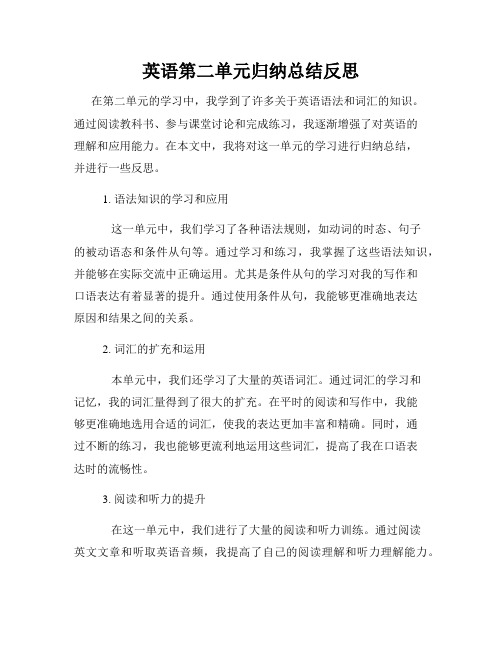
英语第二单元归纳总结反思在第二单元的学习中,我学到了许多关于英语语法和词汇的知识。
通过阅读教科书、参与课堂讨论和完成练习,我逐渐增强了对英语的理解和应用能力。
在本文中,我将对这一单元的学习进行归纳总结,并进行一些反思。
1. 语法知识的学习和应用这一单元中,我们学习了各种语法规则,如动词的时态、句子的被动语态和条件从句等。
通过学习和练习,我掌握了这些语法知识,并能够在实际交流中正确运用。
尤其是条件从句的学习对我的写作和口语表达有着显著的提升。
通过使用条件从句,我能够更准确地表达原因和结果之间的关系。
2. 词汇的扩充和运用本单元中,我们还学习了大量的英语词汇。
通过词汇的学习和记忆,我的词汇量得到了很大的扩充。
在平时的阅读和写作中,我能够更准确地选用合适的词汇,使我的表达更加丰富和精确。
同时,通过不断的练习,我也能够更流利地运用这些词汇,提高了我在口语表达时的流畅性。
3. 阅读和听力的提升在这一单元中,我们进行了大量的阅读和听力训练。
通过阅读英文文章和听取英语音频,我提高了自己的阅读理解和听力理解能力。
同时,通过与同学进行讨论和合作,我也学会了更好地理解和解释所读和所听内容,提高了我的沟通能力。
总结起来,英语第二单元的学习对我的英语能力提高有着显著的影响。
通过学习语法规则、扩充词汇、进行阅读和听力练习,我不仅增强了自己的英语语言能力,也提高了自己的学习和应用能力。
此外,课堂上的讨论和合作让我更好地理解和掌握所学知识。
在接下来的学习中,我将继续努力,巩固和拓展所学的内容,以进一步提高我的英语能力。
总的来说,英语第二单元的学习让我受益匪浅。
通过对语法知识和词汇的学习,我能够更准确地表达自己的思想和观点。
通过阅读和听力的练习,我对英语的理解和运用能力得到了提高。
我相信,在未来的学习和实践中,我会继续努力,不断提高自己的英语水平。
总结概括能力英文作文
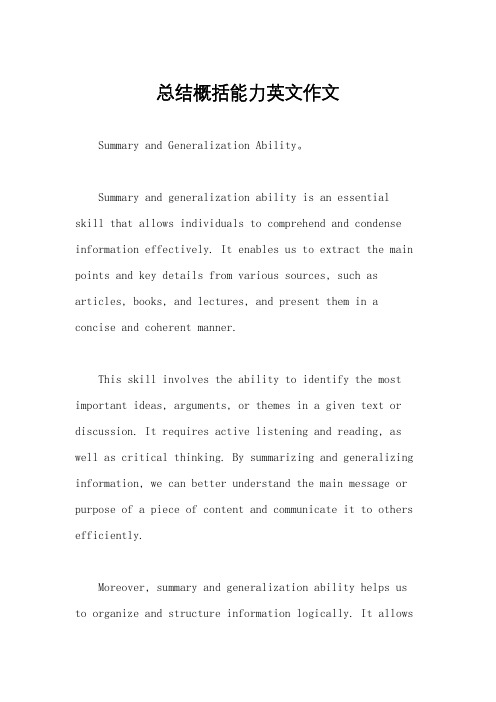
总结概括能力英文作文Summary and Generalization Ability。
Summary and generalization ability is an essentialskill that allows individuals to comprehend and condense information effectively. It enables us to extract the main points and key details from various sources, such as articles, books, and lectures, and present them in a concise and coherent manner.This skill involves the ability to identify the most important ideas, arguments, or themes in a given text or discussion. It requires active listening and reading, as well as critical thinking. By summarizing and generalizing information, we can better understand the main message or purpose of a piece of content and communicate it to others efficiently.Moreover, summary and generalization ability helps us to organize and structure information logically. It allowsus to categorize and group related ideas or concepts, making it easier to remember and recall information. By condensing complex information into a succinct form, we can also enhance our own understanding of the subject matter.In addition, this skill is crucial for effective communication. Being able to summarize and generalize information enables us to convey key points to others in a clear and concise manner. Whether it is in a formal presentation, a casual conversation, or a written report, the ability to summarize and generalize allows us to articulate our thoughts and ideas effectively.Furthermore, summary and generalization ability is closely linked to critical thinking. It requires us to analyze and evaluate information, distinguishing between essential and non-essential details. By critically assessing the credibility and relevance of information, we can make informed judgments and decisions.In conclusion, summary and generalization ability is a vital skill that allows us to comprehend, condense, andcommunicate information effectively. It involves identifying key points, organizing information logically, and conveying ideas clearly. By developing this skill, we can enhance our understanding of various subjects and improve our overall communication and critical thinking abilities.。
归纳总结用英文翻译一下

归纳总结用英文翻译一下Title: A Brief Summary of English Translation TechniquesIntroduction:English translation is an essential skill in today's globalized world. It allows individuals and businesses to communicate, connect, and collaborate across different cultures and languages. However, achieving accurate and fluent translations requires a solid understanding of various techniques and strategies. In this article, we will explore and summarize some common English translation techniques.I. Literal Translation:Literal translation is the most basic technique, where words and phrases are translated directly without considering context or cultural differences. While this approach ensures accuracy, it often results in awkward and unnatural-sounding sentences. Thus, literal translation is best used when dealing with technical or scientific texts, where precision is paramount.Example: "你好" translates to "hello" in English.II. Transposition:Transposition involves changing the grammatical structure or word order of a sentence while preserving the original meaning. This technique is useful when the sentence structure in the target language differs from that of the source language.Example: "我在图书馆看书" can be transposed to "I read books at the library" in English.III. Modulation:Modulation entails conveying the same meaning using different expressions or words. It is commonly used to capture nuances, idiomatic expressions, and cultural variations that may not have a direct equivalent in the target language.Example: "一帆风顺" can be modulated as "smooth sailing" in English.IV. Equivalence:Equivalence involves finding the closest equivalent in the target language for a specific word or phrase in the source language. It requires a thorough understanding of both languages' vocabulary and idiomatic expressions.Example: "绿色" can be translated as "green" in most contexts, but it may also be equivalent to "environmentally friendly" or "eco-friendly" in certain cases.V. Adaptation:Adaptation involves modifying the source text to suit the cultural, linguistic, or social norms of the target audience. It is commonly used in literary translations or when translating advertisements, slogans, or marketing materials.Example: "Just Do It" by Nike is adapted as "只管去做" in Chinese, which captures the essence and motivational message of the original phrase.VI. Compensation:Compensation occurs when certain aspects of the source text cannot be accurately translated, and thus, the translator compensates by emphasizing or elaborating on other elements of the text to convey the intended meaning.Example: In translating jokes or puns, the humor may be lost, so the translator compensates by focusing on the underlying concept or a different form of humor that resonates with the target audience.Conclusion:English translation techniques play a vital role in ensuring accurate and fluent communication across different languages and cultures. While these techniques provide a foundation for effective translation, it is essential for translators to adapt their approach based on the specific context, subject matter, and intended audience. By continuously honing their skills and applying these techniques judiciously, translators can bridge language gaps and facilitate meaningful interactions between people from diverse backgrounds.。
计划与总结的能力英语
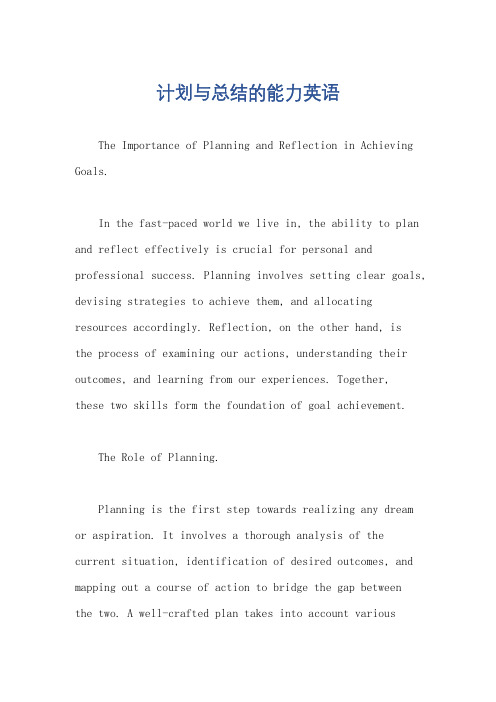
计划与总结的能力英语The Importance of Planning and Reflection in Achieving Goals.In the fast-paced world we live in, the ability to plan and reflect effectively is crucial for personal and professional success. Planning involves setting clear goals, devising strategies to achieve them, and allocating resources accordingly. Reflection, on the other hand, isthe process of examining our actions, understanding their outcomes, and learning from our experiences. Together,these two skills form the foundation of goal achievement.The Role of Planning.Planning is the first step towards realizing any dreamor aspiration. It involves a thorough analysis of thecurrent situation, identification of desired outcomes, and mapping out a course of action to bridge the gap betweenthe two. A well-crafted plan takes into account variousfactors such as resources, time, and potential obstacles. It ensures that efforts are focused and directed towards achieving specific goals.In the realm of business, for example, planning is essential for success. Companies need to plan their strategies, set financial targets, and outline marketing plans to attract customers. Similarly, individuals must plan their careers, set professional goals, and acquire necessary skills to progress in their chosen fields.Effective planning also involves contingency planning, which anticipates potential problems and challenges and prepares solutions accordingly. This flexibility allows for smooth navigation through unexpected obstacles, ensuring that the overall objectives are not compromised.The Importance of Reflection.Reflection is the other crucial component of goal achievement. It involves looking back at our actions, understanding their impact, and identifying areas forimprovement. Reflection helps us learn from our mistakes, gain insights into our behavior, and develop a deeper understanding of ourselves and our capabilities.Reflection is particularly beneficial in complex or challenging situations where traditional planning techniques may not suffice. By reflecting on past experiences, we can gain valuable insights into what worked well and what didn't, allowing us to make more informed decisions in the future.In addition, reflection fosters a culture of continuous learning and personal growth. It encourages us to question our assumptions, challenge our beliefs, and explore new possibilities. This open-minded approach to learning is essential for staying agile and responsive to changing environments.Integration of Planning and Reflection.The most effective approach to goal achievement is the integration of planning and reflection. This involvessetting clear goals, devising strategies to achieve them, allocating resources, and then continuously evaluating the progress made.By reflecting on the implementation of the plan, we can identify areas where the strategy is working well and where adjustments are needed. This iterative process of planning and reflection allows us to adapt our strategies to changing circumstances, learn from our mistakes, and continuously improve our performance.Moreover, the integration of planning and reflection fosters a mindset of continuous improvement. It encourages us to view challenges as opportunities for growth and learning, rather than obstacles to be overcome. This positive approach to challenges helps us maintain momentum and stay focused on our goals even when faced with difficulties.In conclusion, the ability to plan and reflect effectively is essential for achieving goals. Planning allows us to set clear objectives, devise strategies toachieve them, and allocate resources accordingly. Reflection helps us learn from our experiences, gain insights into our behavior, and continuously improve our performance. By integrating these two skills, we can achieve our goals more efficiently and effectively, while also fostering a mindset of continuous learning and personal growth.。
归纳总结法的英文翻译
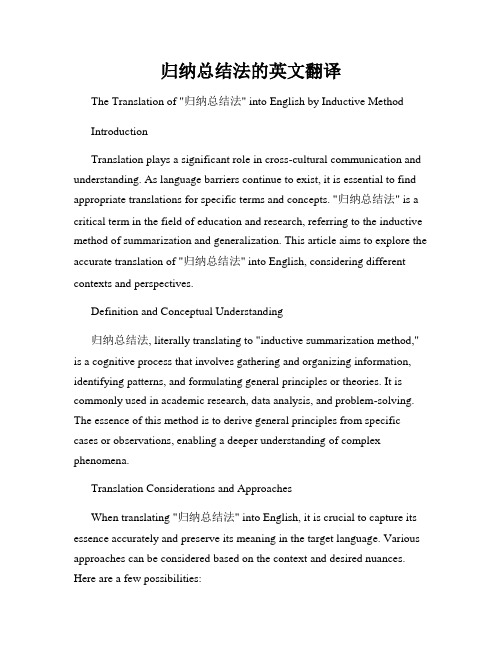
归纳总结法的英文翻译The Translation of "归纳总结法" into English by Inductive MethodIntroductionTranslation plays a significant role in cross-cultural communication and understanding. As language barriers continue to exist, it is essential to find appropriate translations for specific terms and concepts. "归纳总结法" is a critical term in the field of education and research, referring to the inductive method of summarization and generalization. This article aims to explore the accurate translation of "归纳总结法" into English, considering different contexts and perspectives.Definition and Conceptual Understanding归纳总结法, literally translating to "inductive summarization method," is a cognitive process that involves gathering and organizing information, identifying patterns, and formulating general principles or theories. It is commonly used in academic research, data analysis, and problem-solving. The essence of this method is to derive general principles from specific cases or observations, enabling a deeper understanding of complex phenomena.Translation Considerations and ApproachesWhen translating "归纳总结法" into English, it is crucial to capture its essence accurately and preserve its meaning in the target language. Various approaches can be considered based on the context and desired nuances. Here are a few possibilities:1. Inductive MethodThe phrase "inductive method" is a direct translation of "归纳总结法." It clearly conveys the idea of deriving general principles from specific instances. This translation is suitable in the context of academic research or scientific analysis, where the focus is on the logical process of drawing conclusions from evidence.2. Summative Induction"Summative induction" is another potential translation option. It emphasizes the act of summarizing or consolidating information to identify overarching patterns or principles. This translation may be appropriate in fields such as data analysis or statistics, where researchers summarize collected data to generate meaningful insights.3. Generalization ApproachThe term "generalization approach" can also be considered as a translation of "归纳总结法." This translation emphasizes the process of formulating general principles from specific cases or observations. It is particularly relevant in educational contexts, where teachers guide students to identify common characteristics or patterns among various examples.Choosing the most suitable translation depends on the specific context and desired emphasis. It is crucial to consider the audience and purpose of the translation to ensure clarity and accuracy.Applications and ExamplesThe application of "归纳总结法" is widespread in various fields, including education, research, and problem-solving. Here are a few examples to illustrate its usage:1. Educational ResearchIn educational research, the inductive method is often employed to analyze classroom observations or student performance. Researchers gather specific data, such as student behaviors or test scores, and use the inductive method to generalize patterns or principles that can inform teaching strategies or curriculum design.2. Data AnalysisIn data analysis, the inductive method is utilized to identify patterns or trends within datasets. Researchers collect specific data points, such as survey responses or sales figures, and summarize them using the inductive method to extract meaningful insights. This approach is particularly useful in market research or social science studies.3. Problem-SolvingThe inductive method is also valuable in problem-solving scenarios. By examining specific instances or cases, individuals can identify common factors or patterns, leading to potential solutions or strategies. This approach is widely used in fields such as engineering, management, and decision-making.ConclusionThe accurate translation of "归纳总结法" into English requires careful consideration of its conceptual underpinnings, context, and desired emphasis. We have explored various translation options, including "inductive method," "summative induction," and "generalization approach," each with its own nuances and applicability. Ultimately, the choice of translation should align with the purpose and context of usage, ensuring a clear understanding of this fundamental cognitive process.。
收集归纳总结能力英文

收集归纳总结能力英文IntroductionDeveloping the ability to collect, organize, and summarize information is essential for effective communication and academic success. In this article, we will explore the importance of developing these skills in the English language context. We will discuss strategies and techniques that can be employed to enhance one's ability to collect, organize, and summarize information in English effectively.Section 1: The Importance of Collecting InformationCollecting relevant information is the first step towards acquiring knowledge or completing a task successfully. Whether it is conducting research, preparing for a presentation, or writing an essay, gathering accurate and reliable information is crucial. In the English language context, this skill becomes even more critical as it involves sourcing information from diverse English language resources.Section 2: Strategies for Collecting Information in English1. Utilize Online Databases and Resources: The internet provides access to a vast array of English language resources such as academic journals, online libraries, and databases. It is essential to learn how to navigate and utilize these resources effectively to collect accurate and up-to-date information.2. Develop Effective Reading Skills: Reading comprehension is vital for collecting information. Practice active reading techniques such as skimming,scanning, and note-taking to extract relevant information efficiently. Additionally, improving vocabulary and language skills will aid in understanding complex texts.3. Engage in Conversations and Interviews: Engaging in discussions with experts, peers, or native English speakers can provide valuable insights and firsthand information. Conducting interviews, either in person or online, can be an excellent way to gather specific information or personal experiences.Section 3: Organizing Information EffectivelyOnce information is collected, organizing it in a logical and coherent manner is crucial to ensure clarity and coherence in communication or academic tasks. Here are some strategies to consider:1. Create Outlines: Outlining the main ideas and supporting details will provide a clear structure for organizing information. This can be done through bullet points, mind maps, or hierarchical diagrams.2. Categorize Information: Group related information into categories or sections to make the content more easily digestible. This could involve classifying data based on themes, topics, or chronological order.3. Use Visual Aids: Incorporating visual aids, such as charts, graphs, or tables, can help present complex information in a visually appealing and accessible manner. This allows for easy comprehension and enhances the overall organization of the content.Section 4: Summarizing Information EffectivelySummarizing information involves condensing large amounts of data or text into concise and coherent summaries. Here are some techniques to develop effective summarizing skills:1. Focus on Key Points: Identify the most important ideas or arguments within the information collected. Highlight these key points and disregard irrelevant or redundant details.2. Paraphrasing and Synthesizing: Practice summarizing the main ideas in your own words while maintaining the integrity of the original information. Avoid plagiarism by properly citing any sources used.3. Use Summarizing Tools: Utilize online tools or software that can help automatically generate summaries of lengthy texts. While these tools can be useful, ensure that they are reliable and accurate.ConclusionDeveloping the ability to collect, organize, and summarize information in English is crucial for effective communication and academic success. By employing strategies such as utilizing online resources, improving reading skills, organizing information effectively, and practicing summarizing techniques, one can enhance their abilities in this area. Remember, continuous practice, exposure to English language resources, and seeking feedback from peers or instructors will contribute to the growth and development of these essential skills.。
总结的英文短语
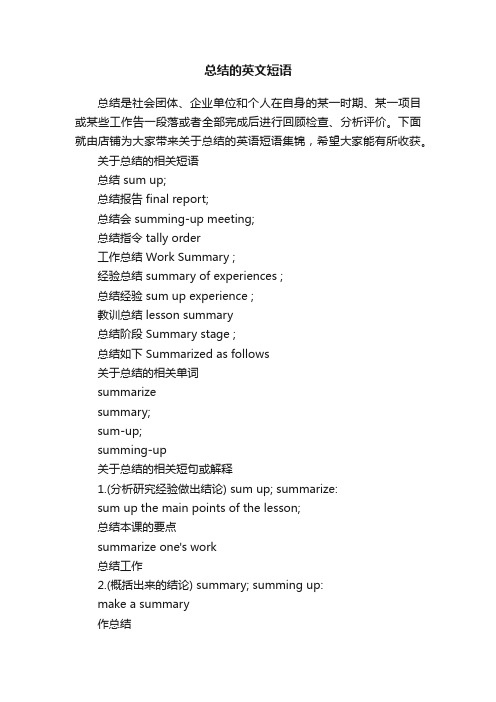
总结的英文短语总结是社会团体、企业单位和个人在自身的某一时期、某一项目或某些工作告一段落或者全部完成后进行回顾检查、分析评价。
下面就由店铺为大家带来关于总结的英语短语集锦,希望大家能有所收获。
关于总结的相关短语总结 sum up;总结报告 final report;总结会 summing-up meeting;总结指令 tally order工作总结 Work Summary ;经验总结 summary of experiences ;总结经验 sum up experience ;教训总结 lesson summary总结阶段 Summary stage ;总结如下 Summarized as follows关于总结的相关单词summarizesummary;sum-up;summing-up关于总结的相关短句或解释1.(分析研究经验做出结论) sum up; summarize:sum up the main points of the lesson;总结本课的要点summarize one's work总结工作2.(概括出来的结论) summary; summing up:make a summary作总结关于总结的相关例句1. Obree summed his weekend up in one word: "Disastrous."奥布瑞用一个词总结了他的周末经历:“灾难。
”2. He summed up his philosophy, with reference to Calvin.他总结了自己的哲学,还提及了加尔文。
3. "It's a waste of time," he concluded.“这是浪费时间。
”他总结道。
4. Table 3.1 summarizes the information given above.表格3.1是对以上信息的总结。
年终总结英文版优秀
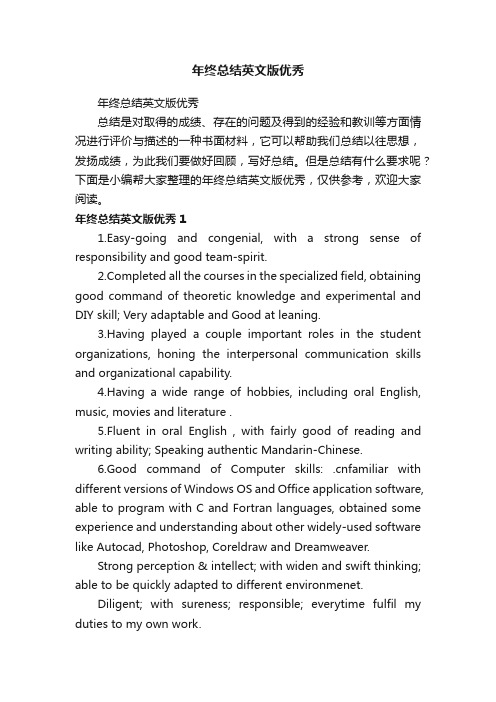
年终总结英文版优秀年终总结英文版优秀总结是对取得的成绩、存在的问题及得到的经验和教训等方面情况进行评价与描述的一种书面材料,它可以帮助我们总结以往思想,发扬成绩,为此我们要做好回顾,写好总结。
但是总结有什么要求呢?下面是小编帮大家整理的年终总结英文版优秀,仅供参考,欢迎大家阅读。
年终总结英文版优秀11.Easy-going and congenial, with a strong sense of responsibility and good team-spirit.pleted all the courses in the specialized field, obtaining good command of theoretic knowledge and experimental and DIY skill; Very adaptable and Good at leaning.3.Having played a couple important roles in the student organizations, honing the interpersonal communication skills and organizational capability.4.Having a wide range of hobbies, including oral English, music, movies and literature .5.Fluent in oral English , with fairly good of reading and writing ability; Speaking authentic Mandarin-Chinese.6.Good command of Computer skills: .cnfamiliar with different versions of Windows OS and Office application software, able to program with C and Fortran languages, obtained some experience and understanding about other widely-used software like Autocad, Photoshop, Coreldraw and Dreamweaver.Strong perception & intellect; with widen and swift thinking; able to be quickly adapted to different environmenet.Diligent; with sureness; responsible; everytime fulfil my duties to my own work.Conscientiously, absorbedly work in a planned and order way; pursue the perfection.Good image; temperate, calm and steady personality; strong affinity; good at getting along with people.Patient; have holding capacity to pressure and setback.年终总结英文版优秀2The end of the year is often a time of many events - wrapping up business for the year while also wrapping holiday presents. This article presents something you can give to yourself - something that you can get done during the holiday lull or over some vacation days - a quick and easy process for examining what youve accomplished in your career this year and where you want to go with it next year.Of course, you may have already done at least some preliminary work on reviewing the year - especially if your employer hands out year-end bonuses or conducts year-end performance reviews - and if so, thats a good place to start your year-end review.But unlike your on-the-job performance review, the purpose of this article is to suggest you consider conducting an even more important assessment - taking stock of your career. Now is the perfect time to review where you are, where youve been, and where you want to go.Before you begin your assessment, take a moment to ask yourself the most important question: Am I happy and fulfilled by my job and career? No matter how successful youve been in the past 11 months, if you are fundamentally unhappy with your work, spend the vast majority ofDont rush your review. Consider using a weekend or one or more of your vacation days to reflect on your career. You dontneed to - and probably shouldnt - complete all six steps in one sitting. Break it up over several days if you like.Step One: Review Career Goals. Did you set any goals for your career this year - formally or informally? Most people have some idea of what they want to accomplish next in their careers, such as getting a promotion and/or raise or perhaps achieving better work/life balance. Setting some goals is an important activity because goals help provide the focus you need to move your career forward - and to avoid distractions or activities that may slow your career progress (or worse, devalue you). So, if you had any goals for this year, answer these questions:1.Did I achieve my career goals?2.Am I satisfied with what I did relative to my goals?3.Did anything happen to change my goals over the course of the year?4.How should I modify my goals for next year?Step Two: Review Your Career Year. What have you done this year? This step is about documenting your career progression and identifying key achievements. Thinking about all youve done over the past 11 months or so, ask yourself these questions:1.What have I accomplished?2.What new skills have I acquired?3.What have I learned?4. What opportunities were gained and lost?5. How am I better today than I was at the beginning of the year?Step Three: Develop Your Career Synopsis. Where are you in your career? Review all aspects of your career and examine where you stand at this juncture. Some questions to ask yourself:1. Am I where I should be in my career?2. What has helped or hindered my progression?3. Am I happy with my current employer?4.What are my strengths and weakness?Step Four: Envision Your Future. Whats your next career step? Take some time to plan for next year (and perhaps beyond), picturing the path you want your career to take. Again, here are some questions to help you:1.What do I want to be doing more of in my career?2. What do I want to be doing less of in my career?3. Whats the next step in my career?4.When should I be taking this next step?5.Whats my ideal/ultimate career dream?Step Five: Action Steps for Your Future. How will you get to that future career? Make a list of what you need to do - career goals for the coming year - to get to where you want to be next in your career. These might be things such as building your network, gaining additional experiences, changing employers, strengthening your career brand, or pursuing additional training/education/certifications. Questions to ask yourself:1. What do I need to prepare myself for this next step?2. Do I need to find a new employer to make the next step?3. How do I position myself for this next step?Step Six: Share Your Career Vision. Are your career goals and action plans feasible? Schedule a meeting with your mentors and to get reactions to your plan, as well as advice for achieving it.Final ThoughtsOnce youve completed these six steps, you should not only know yourself and your career better, but have some specific goals and action steps to help you progress along a career plan.Another benefit from completing this year-end review is thatthe results from part of the analysis should assist you in updating your resume if you have not been keeping it current as the year progressed. Even if you are extremely happy with your employer, it makes sense to have a current resume for that once-in-a-lifetime opportunity, or worse, if your employer decides its time to downsize the workforce.。
总结概括能力英文作文
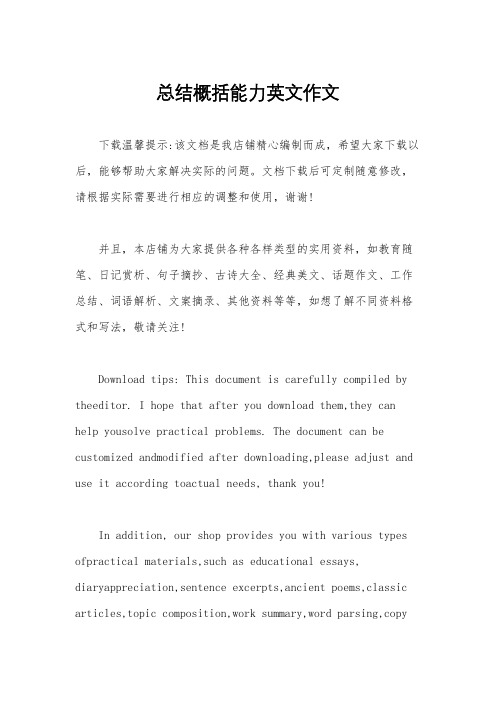
总结概括能力英文作文下载温馨提示:该文档是我店铺精心编制而成,希望大家下载以后,能够帮助大家解决实际的问题。
文档下载后可定制随意修改,请根据实际需要进行相应的调整和使用,谢谢!并且,本店铺为大家提供各种各样类型的实用资料,如教育随笔、日记赏析、句子摘抄、古诗大全、经典美文、话题作文、工作总结、词语解析、文案摘录、其他资料等等,如想了解不同资料格式和写法,敬请关注!Download tips: This document is carefully compiled by theeditor. I hope that after you download them,they can help yousolve practical problems. The document can be customized andmodified after downloading,please adjust and use it according toactual needs, thank you!In addition, our shop provides you with various types ofpractical materials,such as educational essays, diaryappreciation,sentence excerpts,ancient poems,classic articles,topic composition,work summary,word parsing,copyexcerpts,other materials and so on,want to know different data formats andwriting methods,please pay attention!Summary and generalization ability is an importantskill that helps individuals to grasp the main points of information quickly and efficiently. It allows us to condense complex ideas into concise and understandable summaries.Being able to summarize effectively requires strong analytical skills and the ability to identify key information. It involves distilling the most important points from a larger body of text or information, and presenting them in a clear and organized manner.Summary and generalization skills are essential in both academic and professional settings. In academic writing, the ability to summarize allows students to demonstrate their understanding of a topic and present their ideas in a coherent and structured way. In the workplace, summarizing information is often necessary for making decisions, communicating with colleagues, and presenting findings tostakeholders.Developing strong summary and generalization skills takes practice and patience. It requires active engagement with the material, critical thinking, and the ability to see the bigger picture. By honing these skills, individuals can become more efficient and effective communicators, thinkers, and problem solvers.In conclusion, summary and generalization ability is a valuable skill that can benefit individuals in various aspects of their lives. It allows us to extract the essence of information, communicate it effectively, and make informed decisions based on a clear understanding of key points. By developing and honing this skill, individuals can enhance their academic performance, professional success, and overall cognitive abilities.。
关于总结的相关单词

关于总结的相关单词summarize.summary(only the main points of sth,not the details.)sum-up;summing-uprun-downgeneralize归纳,概括,笼统地讲,概括地谈论conclude关于summary的相关短语总结sum up总结报告final report;总结会summing-up meeting;工作总结Work Summary ;经验总结summary of experiences ;教训总结lesson summary表总结的一些短语In conclusion 综上所述In a word总而言之In all ,to all 总之;In short ,总之,总而言之Broadly speaking 总而言之;In brief,简单地说,简而言之In a few words.简单地说To be brief,简言之;Briefly,简单地说;In sum,总之A n y w a y,不管怎么说;Anyhow,不管怎么说Altogetherly,总而;All in all 总的来说,大体而言To sum up总之,总而言之;As a result 结果,因此In one word一句话,总而言之At any rate,无论如何,不管The long and the short of the matter 总而言之First and last总之关于总结的相关部分短句与例句1.(分析研究经验做出结论) sum up; summarizesum up the main points of the lesson;总结本课的要点summarize one's work总结工作2.(概括出来的结论) summary; summing up:make a summary作总结3.t o make the long story short 总而言之To make the long story short ,what this man really want s is money总而言之,这个男人所要的都是钱。
年终总结长处技能英文

年终总结长处技能英文IntroductionAs the year comes to a close, it is a time for reflection and evaluation of our achievements and growth. In this year-end summary, I will outline my strengths and skills developed in the year 2021. It has been a year of challenges and opportunities for growth, and through it all, I have honed my abilities and made significant progress.Professional Skills1. CommunicationEffective communication is the cornerstone of success in any professional setting. Throughout the year, I have consistently polished my communication skills. I have learned to express my ideas concisely and clearly, both in written and verbal forms. Additionally, I have become proficient in utilizing various communication tools, such as email, video conferencing, and presentation platforms, to effectively convey information and collaborate with colleagues.2. Time ManagementTime management plays a vital role in achieving productivity and meeting deadlines. In 2021, I have enhanced my time management skills by effectively prioritizing tasks, setting realistic goals, and creating organized schedules. By utilizing techniques like the Pomodoro Technique and task batching, I have improved my efficiency and met project milestones. This skill has not only increased my productivity but also reduced stress levels, enabling me to achieve a healthy work-life balance.3. Problem SolvingThe ability to identify and resolve problems is crucial for professional growth. Over the past year, I have developed strong problem-solving skills by approaching challenges with a systematic and analytical mindset. I have learned to break down complex problems into smaller, manageable tasks, conduct thorough research, and consider different perspectives to find optimal solutions. This skill has empowered me to handle difficult situations and contribute valuable insights to my team.4. AdaptabilityIn today's fast-paced and ever-changing work environment, adaptability is indispensable. Throughout this year, I have demonstrated my ability to quickly adapt to new technologies, work processes, and team dynamics. This flexibility has allowed me to embrace change and thrive in ambiguous situations. I am always open to learning and acquiring new skills to keep up with the evolving demands of the professional world.Personal Strengths1. LeadershipLeadership is not only about delegating tasks but also about inspiring, motivating, and guiding a team towards success. In 2021, I have honed my leadership skills by taking on additional responsibilities and successfully leading projects. By effectively communicating expectations, providing constructive feedback, and fostering a collaborative environment, I have managed to bring out the best in my team members and achieve exceptional results. 2. AdaptabilityAdaptability is not only a professional strength but also a personal strength that has helped me navigate various aspects of life. I have conquered new challenges and overcome obstacles that have come my way. Whether it's personal growth, managing relationships, or pursuing new hobbies, I have demonstrated resilience and adaptability to embrace change and seize opportunities.3. Continuous LearningTo stay ahead in today's dynamic world, continuous learning is essential. I have cultivated a growth mindset and embraced a lifelong learning approach. Throughout the year, I have actively pursued various learning opportunities, such as attending webinars, enrolling in online courses, and seeking feedback from mentors. This commitment to learning has expanded my knowledge base and equipped me with valuable insights and skills. ConclusionThe year 2021 has been a transformative one for me, both professionally and personally. I have fortified my professional skills,including communication, time management, problem-solving, and adaptability. Additionally, my personal strengths in leadership, adaptability, and continuous learning have propelled my growth and achievement. As I move forward into the next year, I am excited to further nurture these strengths and skills, taking on new challenges and contributing to my personal and professional success.。
英文简历能力总结常用句
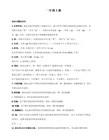
年轻、聪明、精力充沛,并有很强的事业心。
Good people management and communication skills. Team player.
有良好的人员管理和交际能力。能在集体中发挥带头作用。
Able to work under high pressure and time limitation.
能够独立工作、思想成熟、应变能力强。
A person with ability plus flexibility should app1y.
需要有能力及适应力强的人。
A stable personality and high sense of responsibility are desirable.
With good analytical capability.
有较强的分析能力
sporting house 妓院(不是“体育室”) -
dead president 美钞(上印有总统头像)(并非“死了的总统”) -
lover 情人(不是“爱人”)
busboy 餐馆勤杂工(不是“公汽售票员”)
Willing to assume responsibilities.
应聘者须勇于挑重担。
Mature,self-motivated and strong interpersonal skills.
思想成熟、上进心强,并具极丰富的人际关系技巧。
Energetic,fashion-minded person.
肯学习进取。
Good presentation skills.
有良好的表达能力。
总结归纳能力 英文总结能力
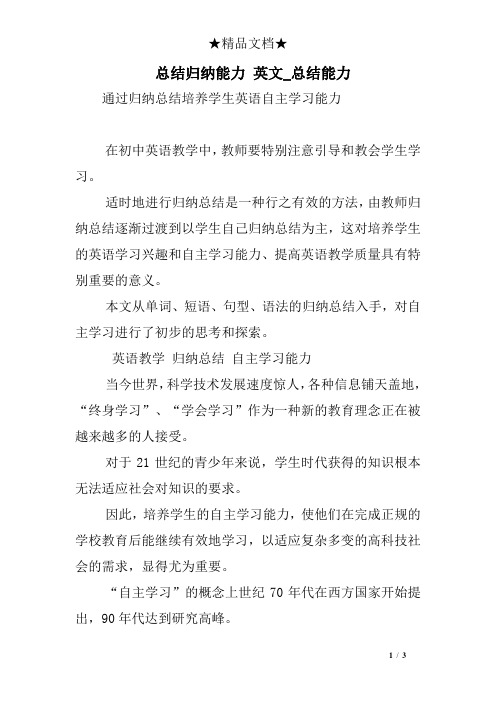
总结归纳能力英文_总结能力通过归纳总结培养学生英语自主学习能力在初中英语教学中,教师要特别注意引导和教会学生学习。
适时地进行归纳总结是一种行之有效的方法,由教师归纳总结逐渐过渡到以学生自己归纳总结为主,这对培养学生的英语学习兴趣和自主学习能力、提高英语教学质量具有特别重要的意义。
本文从单词、短语、句型、语法的归纳总结入手,对自主学习进行了初步的思考和探索。
英语教学归纳总结自主学习能力当今世界,科学技术发展速度惊人,各种信息铺天盖地,“终身学习”、“学会学习”作为一种新的教育理念正在被越来越多的人接受。
对于21世纪的青少年来说,学生时代获得的知识根本无法适应社会对知识的要求。
因此,培养学生的自主学习能力,使他们在完成正规的学校教育后能继续有效地学习,以适应复杂多变的高科技社会的需求,显得尤为重要。
“自主学习”的概念上世纪70年代在西方国家开始提出,90年代达到研究高峰。
Holec (1981)称其为“学习者对自己学习负责的能力”;Dickinson (1995)认为它“既是一种学习态度,又是一种独立学习的能力”。
在中国,于20世纪80年代中后期,许多专家学者也开始了对自主学习的研究。
中国教育部在2000年颁布的《新课标》中把“初步培养中学生的自主学习能力”作为英语教学的主要目标,它要求英语教师要有意识地培养学生在学习和运用英语的过程中逐步学会如何学习并加强对学生学习策略的指导,引导学生运用观察、发现、归纳和实践等方法去学习语言知识。
在中国,学生学习、运用英语的语言环境较差,这很不利于语言知识的掌握和技能、技巧的形成。
根据艾宾浩斯遗忘曲线的规律和教育心理学的建构主义理论,只有对所学知识经常复习巩固,运用自己已有的知识经验主动对所学内容进行信息加工、建构,才能真正地习得知识、技能,而学生的自主学习能力也正是在这个过程中逐步形成、培养起来的。
在教学中,我采用归纳总结法培养学生的自主学习能力,取得了很好的效果。
总结归纳能力很强英文翻译
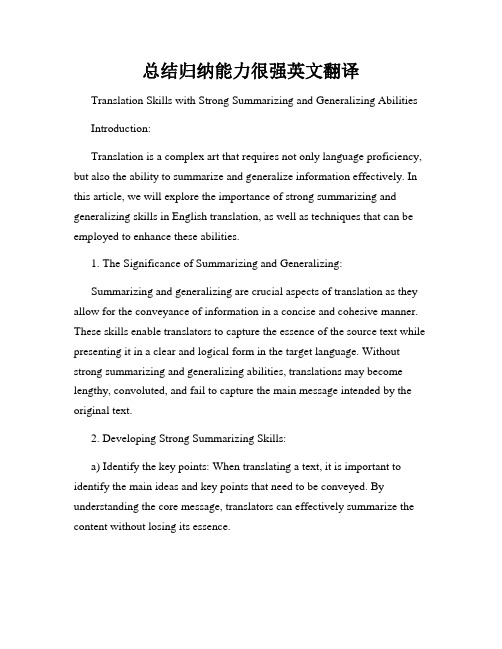
总结归纳能力很强英文翻译Translation Skills with Strong Summarizing and Generalizing AbilitiesIntroduction:Translation is a complex art that requires not only language proficiency, but also the ability to summarize and generalize information effectively. In this article, we will explore the importance of strong summarizing and generalizing skills in English translation, as well as techniques that can be employed to enhance these abilities.1. The Significance of Summarizing and Generalizing:Summarizing and generalizing are crucial aspects of translation as they allow for the conveyance of information in a concise and cohesive manner. These skills enable translators to capture the essence of the source text while presenting it in a clear and logical form in the target language. Without strong summarizing and generalizing abilities, translations may become lengthy, convoluted, and fail to capture the main message intended by the original text.2. Developing Strong Summarizing Skills:a) Identify the key points: When translating a text, it is important to identify the main ideas and key points that need to be conveyed. By understanding the core message, translators can effectively summarize the content without losing its essence.b) Highlight essential details: While summarizing, it is crucial to focus on the most relevant and important information. Extraneous details can be omitted to maintain a concise and impactful translation.c) Use clear and concise language: Summarizing requires the use of clear and concise language to communicate the main ideas effectively. Avoid excessive elaboration or unnecessary repetition, as it can distract from the central message.3. Improving Generalizing Abilities:a) Recognize patterns: Generalizing involves identifying recurring themes, ideas, or patterns within a text. By understanding the underlying structure, translators can provide a cohesive translation that captures the overall meaning.b) Connect related concepts: The ability to connect related concepts is essential in generalizing. Translators should look for connections and associations between different parts of the text, allowing for a coherent and fluid translation.c) Maintain consistency: Generalization requires maintaining consistency in terminology, style, and tone throughout the translation. By adhering to a consistent language style, the translated text will reflect the original message more accurately.4. The Role of Context:Context plays a vital role in translation, aiding in the summarization and generalization process. Translators should consider the broader context ofthe source text, including cultural references or historical background, to accurately capture and convey the intended meaning.5. Utilizing Technology:Technological advancements have greatly facilitated the translation process, offering tools and resources to aid in summarizing and generalizing. Translation software can assist in identifying keywords, concepts, and recurring patterns, allowing translators to navigate complex texts more efficiently.Conclusion:The ability to summarize and generalize information effectively is a critical skill for English translators. By mastering these abilities and employing various techniques, translators can provide concise, accurate, and cohesive translations that faithfully convey the main message of the source text. With continued practice and an understanding of context, translators can enhance their overall proficiency and contribute to successful cross-cultural communication.。
善于总结经验英文6篇
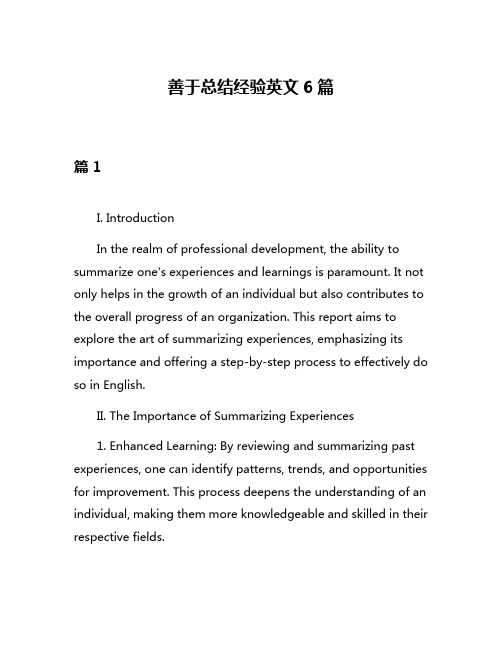
善于总结经验英文6篇篇1I. IntroductionIn the realm of professional development, the ability to summarize one's experiences and learnings is paramount. It not only helps in the growth of an individual but also contributes to the overall progress of an organization. This report aims to explore the art of summarizing experiences, emphasizing its importance and offering a step-by-step process to effectively do so in English.II. The Importance of Summarizing Experiences1. Enhanced Learning: By reviewing and summarizing past experiences, one can identify patterns, trends, and opportunities for improvement. This process deepens the understanding of an individual, making them more knowledgeable and skilled in their respective fields.2. Better Decision-Making: Experience summaries provide a clear picture of past successes and failures, allowing individuals to make more informed decisions in the future. This helps in avoiding mistakes and maximizing the chances of success.3. Continuous Growth: The ability to learn from past experiences allows individuals to grow continuously. This process is integral to career development, as it helps in expanding one's knowledge base and improving performance over time.III. The Process of Summarizing Experiences1. Identify Key Elements: The first step in summarizing an experience is to identify its key elements, including the situation, action taken, results achieved, and any lessons learned. This helps in capturing the essence of the experience and provides a foundation for further analysis.2. Organize Information: Once the key elements are identified, they should be organized in a logical manner. This helps in presenting the information clearly and making it easier for others to understand and relate to the experience.3. Analyze and Extract Lessons: The next step is to analyze the experience and extract relevant lessons learned. This processinvolves looking at the experience from different angles and identifying patterns or trends that may have been missed initially.4. Present the Summary: The final step is to present the experience summary in a clear and concise manner. This can be done through written reports, oral presentations, or any other appropriate medium, depending on the needs of the audience and the purpose of the summary.IV. Conclusion篇2In the vast world of business, being able to总结经验教训is a crucial skill that sets successful individuals apart from the rest. By taking the time to reflect on past experiences and extracting the relevant lessons, we can avoid making the same mistakes and improve our future decisions. This essay will explore the importance of总结经验教训, as well as provide examples and strategies for applying this skill effectively.Firstly, it is essential to understand that总结经验教训is not just about remembering what went wrong but also about identifying the underlying causes and finding solutions toprevent future occurrences. For instance, if an employee makes a mistake in a project, the manager should not only criticize the employee but also conduct a thorough investigation to identify the root cause of the mistake. By doing so, the manager can take corrective measures to prevent similar mistakes from happening again.Moreover,总结经验教训是一个持续的过程,需要在日常工作中不断进行。
归纳总结能力 英文
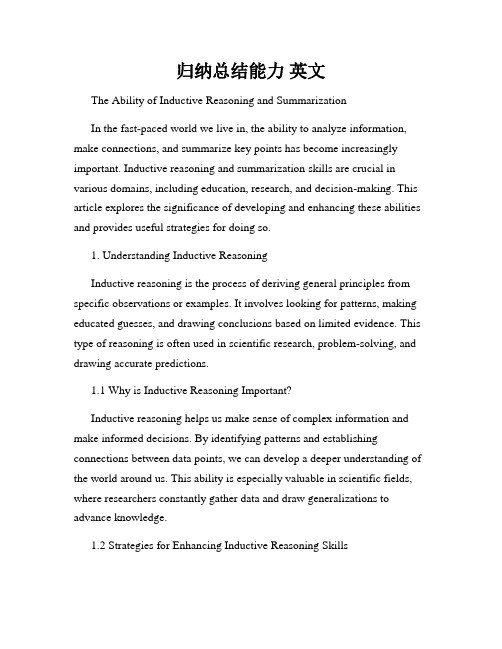
归纳总结能力英文The Ability of Inductive Reasoning and SummarizationIn the fast-paced world we live in, the ability to analyze information, make connections, and summarize key points has become increasingly important. Inductive reasoning and summarization skills are crucial in various domains, including education, research, and decision-making. This article explores the significance of developing and enhancing these abilities and provides useful strategies for doing so.1. Understanding Inductive ReasoningInductive reasoning is the process of deriving general principles from specific observations or examples. It involves looking for patterns, making educated guesses, and drawing conclusions based on limited evidence. This type of reasoning is often used in scientific research, problem-solving, and drawing accurate predictions.1.1 Why is Inductive Reasoning Important?Inductive reasoning helps us make sense of complex information and make informed decisions. By identifying patterns and establishing connections between data points, we can develop a deeper understanding of the world around us. This ability is especially valuable in scientific fields, where researchers constantly gather data and draw generalizations to advance knowledge.1.2 Strategies for Enhancing Inductive Reasoning Skills- Engage in puzzles and brainteasers: These activities force you to think creatively, look for patterns, and make logical connections. Riddles, Sudoku, and crossword puzzles are great examples.- Analyze case studies: Practice drawing general conclusions from specific examples. Analyzing case studies in various fields, such as business or psychology, will help you hone your inductive reasoning skills.- Learn from experience: Reflect on past experiences and consider how they can be applied to present situations. Look for recurring patterns and develop a broader understanding based on these observations.- Stay curious: Ask questions, seek new perspectives, and challenge assumptions. Curiosity fuels inductive reasoning by encouraging exploration and discovery.2. Mastering the Art of SummarizationSummarization is the process of condensing information into concise, coherent, and meaningful summaries. It requires identifying key points, eliminating irrelevant details, and presenting information in a clear and organized manner. Effective summarization skills are beneficial in academic settings, professional environments, and everyday communication.2.1 The Importance of SummarizationIn today's information overload, being able to extract essential information and communicate it efficiently is vital. Summarization enables efficient learning, effective communication, and concise reporting. It helps us identify the main ideas in a text and retain important information.Additionally, summaries are valuable tools for transferring knowledge and sharing key insights with others.2.2 Strategies for Enhancing Summarization Skills- Read actively: Engage with the material by highlighting key points, taking notes, and summarizing main ideas in your own words. Organize the information hierarchically, with the most important points at the top.- Practice paraphrasing: Take a paragraph or an article and rewrite it in a more concise form, while preserving the original meaning. This exercise helps develop your ability to extract essential information and present it in a succinct manner.- Use graphic organizers: Visual tools such as mind maps, concept maps, or flowcharts can help you organize information and identify relationships between ideas. These aids facilitate summarization by providing a clear structure for presenting key points.- Seek feedback: Share your summaries with others and ask for feedback. This will help you identify areas for improvement and refine your summarization skills.ConclusionThe ability to reason inductively and summarize effectively is vital in a world overflowing with information. By honing these skills, we can better understand complex concepts, make informed decisions, and communicate more efficiently. Whether in academic, professional, or everyday life, developing and enhancing our inductive reasoning and summarization abilities will undoubtedly contribute to our success. So, embark on thejourney of cultivating these skills and witness the positive impact they can have on your personal and professional growth.。
英语阅读能力包含哪些-读哪些信息-重要性

英语阅读能力包含哪些-读哪些信息-重要性英语阅读能力包括:快速阅读理解能力;文章体裁辨析能力;文章结构辨析能力;归纳总结能力;生词推测能力等。
想要做好英语阅读,这些能力是必不可少的。
一、快速阅读理解能力在考试中,阅读理解是限时阅读。
它主要考查考生两个方面的阅读理解能力:一是快速阅读能力;二是准确的理解能力。
也就是说,考生在英语阅读理解过程中,阅读速度要快,理解的准确度要高,二者缺一不可。
二、文章体裁辨析能力英语中,由于不同文体的英语文章有不同的写作方法。
如果考生具备了识别英文文体的能力,能依据文体特征迅速抓住文章的要点,就会大大缩短阅读时间,提升理解效率。
三、文章结构辨析能力英语文章有一个共同的特点,一般说来,首先确定文章的主题句,即文章的中心,然后,后面的内容都是围绕这一中心来展开论述的。
中心句一般位于文章最前面,也有的位于文章末尾,还有的位于文章的中间。
有了文章结构的辨析能力,考生就能快速对文章进行全面、系统的掌握。
从而依据试题的不同内容或要求在不同的部位准确找到答案的依据。
四、归纳总结能力虽然绝大多数英语文章有中心句,但也还有些文章根本没有中心句。
如有些描述性的记叙就要求考生依据文章内容来归纳、总结出中心句。
目前高考中的英语试题总有 3~4 题考查考生对文章中心的理解,这就要求考生一定要具有对文章的归纳、总结能力。
五、生词推测能力掌握一定量的词汇是进行阅读的前提,但运用各种英语知识推测生词的能力是考查考生阅读理解能力的一个重要方面。
倘假设单词都不熟悉,也就无法阅读下去。
然而,并不是说,一定要把所有的单词都熟悉才干进行阅读。
事实上,阅读当中出现一些生词,是一件非常正常的事情。
不仅英语阅读如此,就连本族语也是这样。
正因为如此,有些语言专家把阅读戏称为猜词游戏。
因此,考生在英语阅读理解过程中碰到不熟悉的单词时,要依据各种知识大胆地推测生词的意义,培养推测生词意义的能力。
2做英语阅读时要读哪些信息(1)读题干。
英语分析归纳能力怎写范文

英语分析归纳能力怎写范文英文回答:Analytical and inductive abilities in English refer to the skills of analyzing and summarizing information, as well as drawing logical conclusions based on evidence and reasoning. These abilities are crucial in various academic and professional contexts, as they enable individuals to understand complex ideas, make informed decisions, and effectively communicate their thoughts and arguments.To begin with, analytical abilities in English involve the process of breaking down information into its constituent parts and examining their relationships. For example, when reading a scientific research paper, I analyze the methodology, results, and conclusions to understand the study's validity and implications. This analytical approach helps me critically evaluate the information and form my own opinions.Furthermore, inductive abilities in English involve drawing general conclusions based on specific observationsor evidence. For instance, when learning a new grammar rule, I analyze multiple examples to identify patterns and then apply them to similar situations. This inductive reasoning allows me to generalize my understanding and apply it to different contexts.Moreover, analytical and inductive abilities in English are not limited to academic settings. In the workplace, these skills are essential for problem-solving anddecision-making. For example, when faced with a complex project, I analyze the available resources, considerdifferent perspectives, and inductively draw conclusions about the most effective approach. This enables me to make informed decisions and achieve successful outcomes.In addition, analytical and inductive abilities in English also enhance communication skills. When engaging in discussions or debates, these abilities enable me toanalyze different viewpoints, identify logical fallacies, and construct persuasive arguments. By using evidence andreasoning, I can effectively communicate my ideas and influence others.In conclusion, analytical and inductive abilities in English are vital skills that enable individuals to analyze information, draw logical conclusions, and effectively communicate their thoughts and arguments. These abilities are crucial in academic, professional, and interpersonal contexts, as they facilitate critical thinking, problem-solving, and effective communication.中文回答:英语中的分析归纳能力指的是分析和总结信息的能力,以及根据证据和推理得出逻辑结论的能力。
进行归纳总结英文

进行归纳总结英文As we learn and acquire knowledge in any field, it becomes essential to organize and summarize the information we have gathered. The process of summarizing helps us to consolidate our understanding, identify key points, and communicate effectively. In this article, we will explore various methods and techniques for summarizing and synthesizing information in English.1. OutliningOutlining is a commonly used method for organizing and summarizing information. It involves creating a hierarchical structure to represent the main ideas and supporting details of a text. To create an outline, begin by identifying the main topic and then list the major headings and subheadings. Each heading should provide a concise overview of the content it represents. Bullet points or numbering can be used to denote supporting details under each heading.For example, if we were summarizing a book on climate change, our outline might look like this:I. Introduction to climate changeA. Definition and causesB. Historical contextII. Effects of climate changeA. Impact on ecosystemsB. Human health implicationsIII. Mitigation strategiesA. Renewable energy sourcesB. Policy changesIV. Conclusion and call to action2. Mind MappingMind mapping is a visual tool that allows us to create a visual representation of our thoughts and ideas. It is especially useful for summarizing complex concepts or non-linear information. To create a mind map, start with a central idea or topic and then branch out, connecting related ideas with lines or branches. Each branch can represent a subtopic or supporting detail.For instance, if we were summarizing a lecture on artificial intelligence, our mind map might look like this:[Central Idea: Artificial Intelligence]- Types of AI- Machine learning- Neural networks- Expert systems- Applications of AI- Healthcare- Finance- Transportation- Ethical considerations- Job displacement- Privacy concerns3. Summarizing in WritingWhen summarizing information in written form, it is crucial to maintain clarity and conciseness. Start by identifying the main points or arguments and express them in your own words. Avoid including unnecessary details or examples that might obscure the overall message. Use connecting words and phrases such as "in summary," "as a result," or "overall" to guide the reader through the main ideas.For example, if we were summarizing a research paper on the benefits of exercise, our written summary might be:"In summary, the research paper highlights the numerous advantages of regular exercise. The study demonstrates that exercise improves cardiovascular health and enhances overall fitness. Additionally, it provides mental health benefits, such as reducing symptoms of anxiety and depression. Furthermore, exercise plays a crucial role in maintaining healthy body weight and preventing chronic diseases."4. Synthesizing Multiple SourcesSynthesizing multiple sources involves combining information from various texts or research papers to create a coherent and comprehensivesummary. When synthesizing, look for common themes, patterns, or contradictions across the sources. Identify the main arguments or findings from each source and integrate them into a cohesive whole. It is essential to properly cite and attribute the sources used in the synthesis.In conclusion, the process of summarizing and synthesizing information in English is crucial for effective communication and understanding. Whether through outlining, mind mapping, or written summaries, these techniques help us condense complex information into manageable and accessible formats. By mastering these skills, we can enhance our learning experience and effectively convey our knowledge to others.。
英语分析归纳能力怎写范文
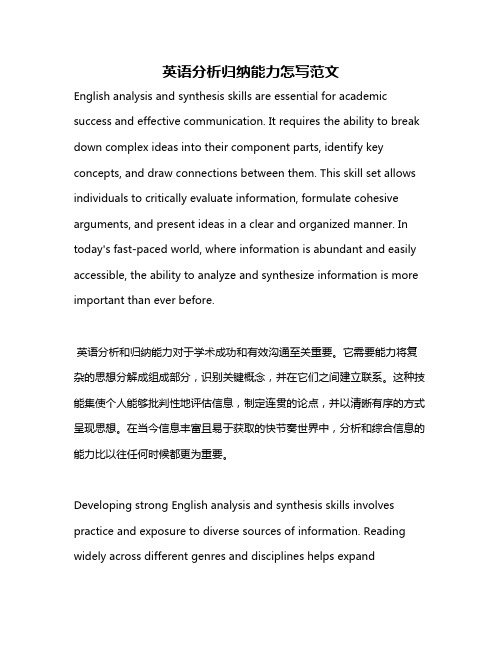
英语分析归纳能力怎写范文English analysis and synthesis skills are essential for academic success and effective communication. It requires the ability to break down complex ideas into their component parts, identify key concepts, and draw connections between them. This skill set allows individuals to critically evaluate information, formulate cohesive arguments, and present ideas in a clear and organized manner. In today's fast-paced world, where information is abundant and easily accessible, the ability to analyze and synthesize information is more important than ever before.英语分析和归纳能力对于学术成功和有效沟通至关重要。
它需要能力将复杂的思想分解成组成部分,识别关键概念,并在它们之间建立联系。
这种技能集使个人能够批判性地评估信息,制定连贯的论点,并以清晰有序的方式呈现思想。
在当今信息丰富且易于获取的快节奏世界中,分析和综合信息的能力比以往任何时候都更为重要。
Developing strong English analysis and synthesis skills involves practice and exposure to diverse sources of information. Reading widely across different genres and disciplines helps expandvocabulary, improve comprehension, and enhance critical thinking abilities. Engaging in discussions, debates, and writing exercises can further refine these skills, as they require individuals to articulate their thoughts effectively and defend their viewpoints with logical reasoning and evidence.培养扎实的英语分析和综合能力需要练习和接触各种信息源。
- 1、下载文档前请自行甄别文档内容的完整性,平台不提供额外的编辑、内容补充、找答案等附加服务。
- 2、"仅部分预览"的文档,不可在线预览部分如存在完整性等问题,可反馈申请退款(可完整预览的文档不适用该条件!)。
- 3、如文档侵犯您的权益,请联系客服反馈,我们会尽快为您处理(人工客服工作时间:9:00-18:30)。
总结归纳能力英文_总结能力
通过归纳总结培养学生英语自主学习能力
在初中英语教学中,教师要特别注意引导和教会学生学习。
适时地进行归纳总结是一种行之有效的方法,由教师归纳总结逐渐过渡到以学生自己归纳总结为主,这对培养学生的英语学习兴趣和自主学习能力、提高英语教学质量具有特别重要的意义。
本文从单词、短语、句型、语法的归纳总结入手,对自主学习进行了初步的思考和探索。
英语教学归纳总结自主学习能力
当今世界,科学技术发展速度惊人,各种信息铺天盖地,“终身学习”、“学会学习”作为一种新的教育理念正在被越来越多的人接受。
对于21世纪的青少年来说,学生时代获得的知识根本无法适应社会对知识的要求。
因此,培养学生的自主学习能力,使他们在完成正规的学校教育后能继续有效地学习,以适应复杂多变的高科技社会的需求,显得尤为重要。
“自主学习”的概念上世纪70年代在西方国家开始提出,90年代达到研究高峰。
Holec (1981)称其为“学习者对自己学习负责的能力”;Dickinson (1995)认为它“既是一种学习态度,又是一种独立学习的能力”。
在中国,于20世纪80年代中后期,许多专家学者也开始了对自主学习的研究。
中国教育部在2000年颁布的《新课标》中把“初步培养中学生的自主学习能力”作为英语教学的主要目标,它要求英语教师要有意识地培养学生在学习和运用英语的过程中逐步学会如何学习并加强对学生学习策略的指导,引导学生运用观察、发现、归纳和实践等方法去学习语言知识。
在中国,学生学习、运用英语的语言环境较差,这很不利于语言知识的掌握和技能、技巧的形成。
根据艾宾浩斯遗忘曲线的规律和教育心理学的建构主义理论,只有对所学知识经常复习巩固,运用自己已有的知识经验主动对所学内容进行信息加工、建构,才能真正地习得知识、技能,而学生的自主学习能力也正是在这个过程中逐步形成、培养起来的。
在教学中,我采用归纳总结法培养学生的自主学习能力,取得了很好的效果。
一、归纳总结单词
在英语学习中,许多同学对记单词感到很头疼,好不容易记住过后又忘了,久而久之,他们对英语学习的兴趣逐渐
减弱、消失,甚至有的同学认为自己不具备学英语的天赋而放弃了英语学习。
在教学中,教师如果试着培养学生总结一些记单词的方法,他们就不会见词生畏了,英语学习就会取得事半功倍的效果。
如:同音词(I 和eye ; two, too, to ),同义词(tip, suggestion, advice “建议”; trip, travel, journey “旅游”),反义词 (thick, thin; take, bring; buy, sell);根据构词法可以把相同前缀(impossible, impolite; unfair, unfriendly)和后缀(beautiful, wonderful; teacher, worker; quietly, carefully, badly)的词归为一类,含有相同字母组合的词归类(thought, bought, cough; meet, speech, sleep),合成词(hometown, classmate, understand)……其实,只要善于动脑、勤于总结,还有许多单词归类法。
教师不妨启发、引导学生用这些方法对学过的单词加以归纳,并鼓励他们另辟奚径,可以收到意想不到的效果。
这些单词记忆。
